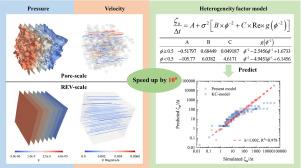Heterogeneity factor model for fluid/meso-structure coupling simulations of nonlinear seepage
IF 6.2
1区 工程技术
Q1 COMPUTER SCIENCE, INTERDISCIPLINARY APPLICATIONS
引用次数: 0
Abstract
Nonlinear seepage plays a crucial role in various engineering applications, yet an accurate prediction remains challenging. By incorporating the concept of the heterogeneity factor , an efficient one-field multiscale approach for seepage prediction has been proposed based on the fundamental principle of fluid/meso-structure interactions. The impact of flow and structural details (including Reynolds number, specific surface area of solid grain, and porosity of porous structure) on such factor are studied in detail. Results show that is proportional to the square of specific surface area and reciprocal to the quadratic polynomial of porosity, and it has a sharp increase followed by a linear change with the increase of Reynolds numbers. A reduced model of fitted from 105 pairs of simulation data is then proposed for performing macroscopic simulations of nonlinear seepage. This model in three-dimension heterogeneous porous media achieves a phenomenal gain of over speed-up compared to pore-scale simulation with a maximum prediction error of only 7.8%, demonstrating an exceptional performance-to-accuracy trade-off. Evidently, it attains a substantially higher degree of accuracy compared to the traditional method that utilizes the Kozeny–Carman permeability model. The present work provides an improved understanding of heterogeneous structure effect on nonlinear seepage, and provides a high-fidelity reduced model needed in large-scale nonlinear seepage simulations.

流体/细观结构耦合非线性渗流模拟的非均质因子模型
非线性渗流在各种工程应用中起着至关重要的作用,但准确的预测仍然具有挑战性。通过引入非均质因子ζu的概念,基于流体/细观结构相互作用的基本原理,提出了一种有效的单场多尺度渗流预测方法。详细研究了流动和结构细节(包括雷诺数、固体晶粒比表面积、多孔结构孔隙率)对该因子的影响。结果表明:ζu与比表面积的平方成正比,与孔隙率的二次多项式成反比,且随着雷诺数的增加先急剧增大后呈线性变化;然后提出了一种由105对模拟数据拟合而成的简化模型,用于非线性渗流的宏观模拟。与孔隙尺度模拟相比,该模型在三维非均质多孔介质中实现了超过105的加速增益,最大预测误差仅为7.8%,证明了卓越的性能与精度权衡。显然,与利用Kozeny-Carman渗透率模型的传统方法相比,该方法的精度要高得多。本研究提高了对非均质结构对非线性渗流影响的认识,并提供了大规模非线性渗流模拟所需的高保真简化模型。
本文章由计算机程序翻译,如有差异,请以英文原文为准。
求助全文
约1分钟内获得全文
求助全文
来源期刊

Computers and Geotechnics
地学-地球科学综合
CiteScore
9.10
自引率
15.10%
发文量
438
审稿时长
45 days
期刊介绍:
The use of computers is firmly established in geotechnical engineering and continues to grow rapidly in both engineering practice and academe. The development of advanced numerical techniques and constitutive modeling, in conjunction with rapid developments in computer hardware, enables problems to be tackled that were unthinkable even a few years ago. Computers and Geotechnics provides an up-to-date reference for engineers and researchers engaged in computer aided analysis and research in geotechnical engineering. The journal is intended for an expeditious dissemination of advanced computer applications across a broad range of geotechnical topics. Contributions on advances in numerical algorithms, computer implementation of new constitutive models and probabilistic methods are especially encouraged.
 求助内容:
求助内容: 应助结果提醒方式:
应助结果提醒方式:


